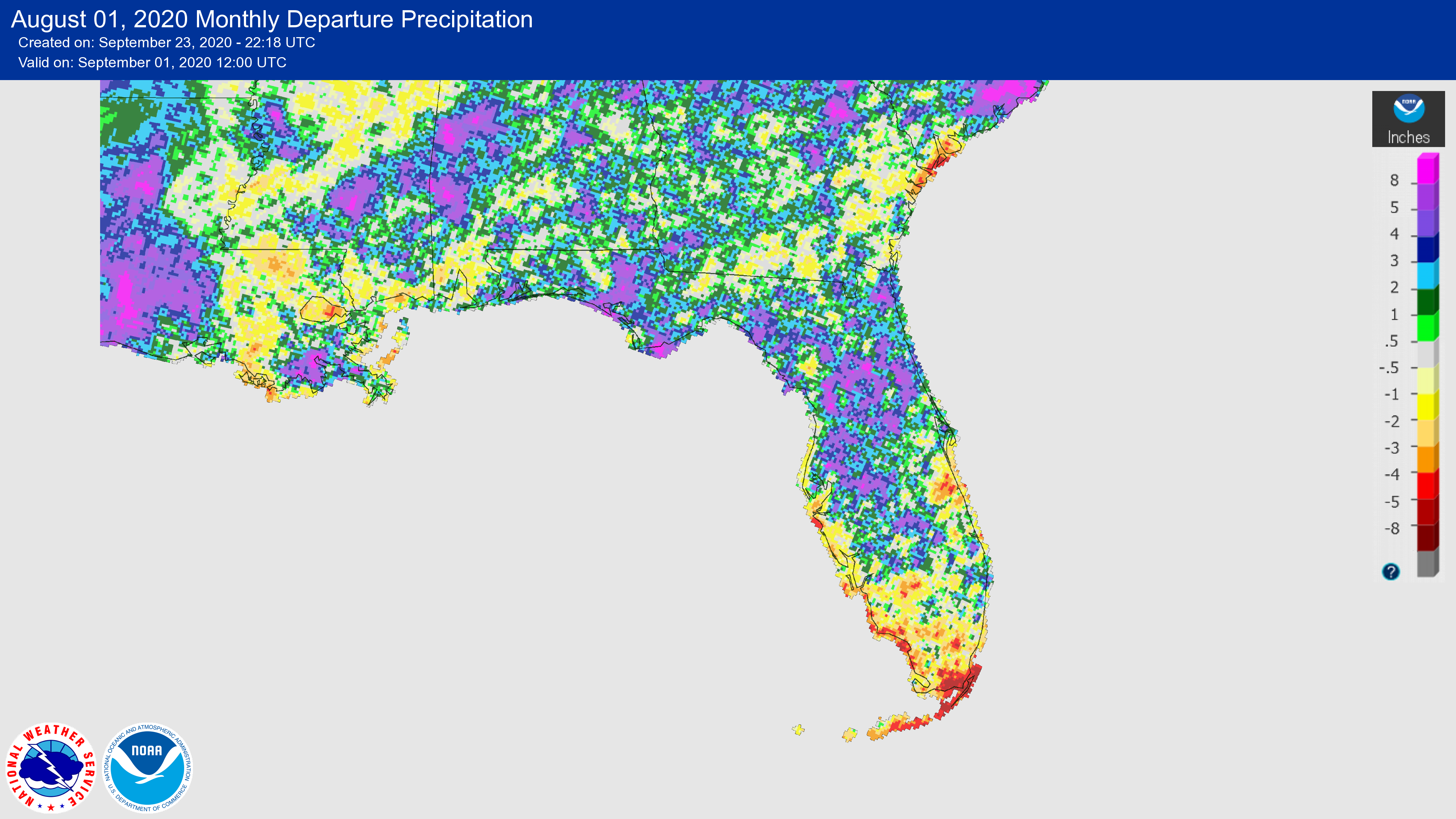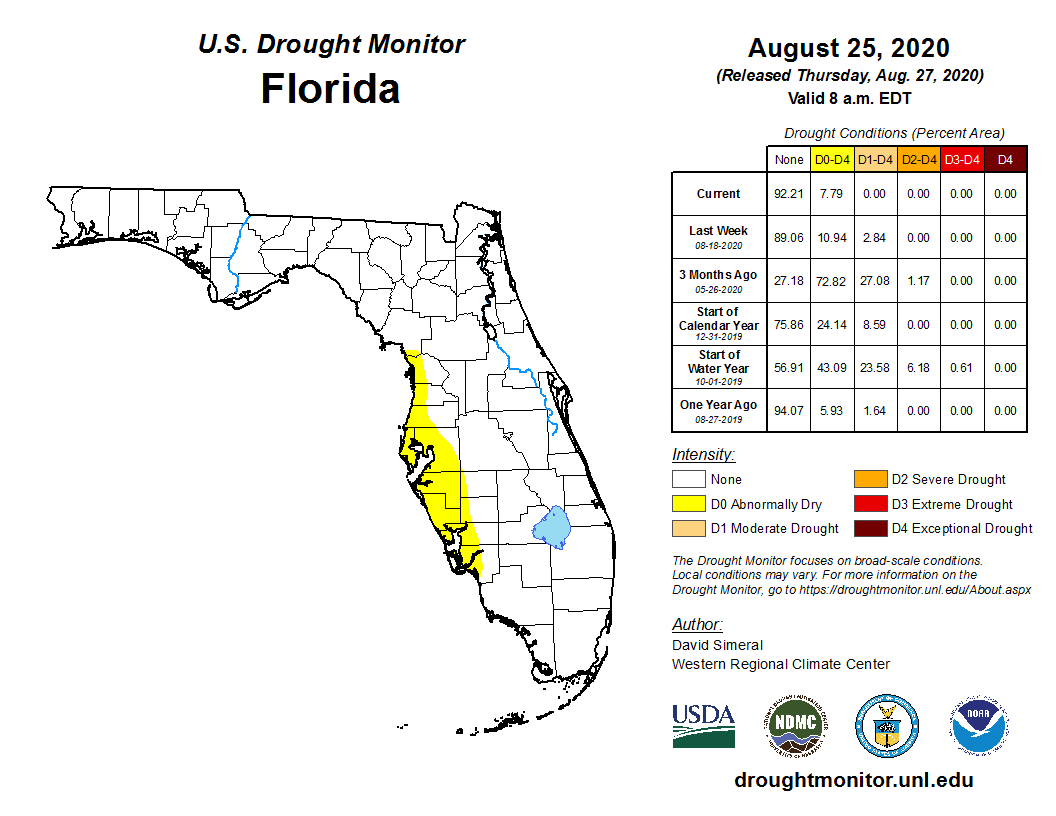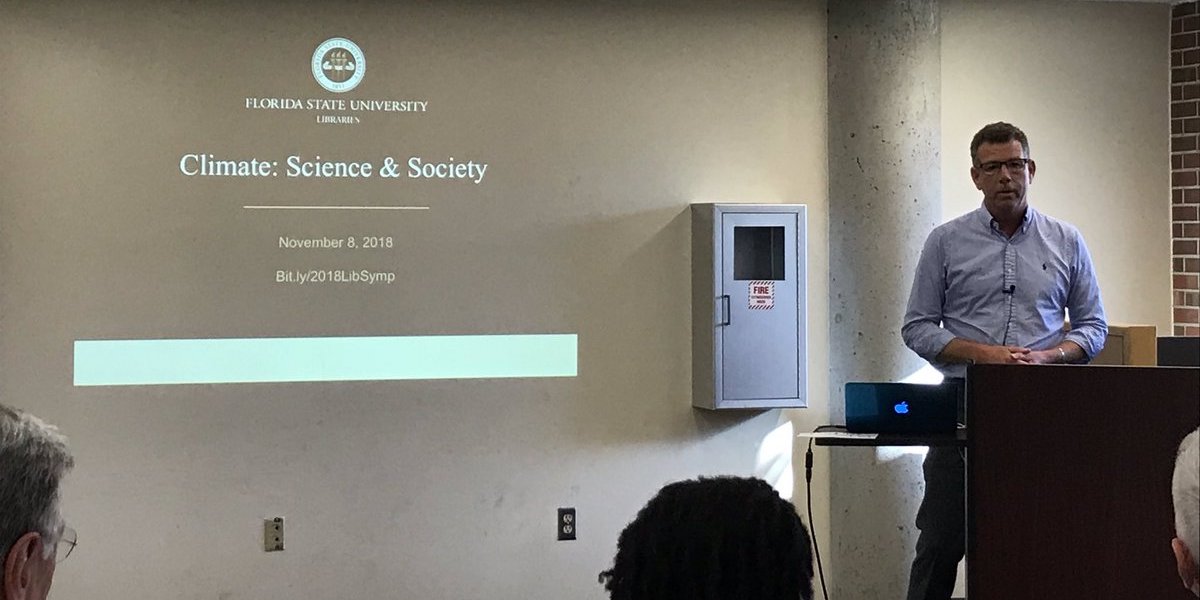Prepared by Florida Climate Center
The Florida State University
Tallahassee, FL
Average temperatures in August were near or above normal. Departures from normal ranged from +0.3 ̊F in Jacksonville to +1.9 ̊F in Key West (Table 1). Sarasota observed its warmest August on record, as well as Miami, which tied with 2017 as the warmest month on record. Key West and Fort Myers had their 2nd warmest August, and Tampa observed its 4th warmest August on record (additional departures are provided in the appendix).
Table 1. August average temperatures and departures from normal ( ̊F) for selected cities.
| Station | Mean Temperature | Departure from Normal |
| Pensacola | 83.2 | +1.4 |
| Tallahassee | 82.6 | +0.4 |
| Jacksonville | 82.2 | +0.3 |
| Orlando | 83.8 | +1.3 |
| Tampa | 84.8 | +1.4 |
| Miami | 85.7 | +1.7 |
| Key West | 87.2 | +1.9 |
Rainfall totals in August were above normal across much of the state, including the western panhandle, north Florida, and parts of central Florida. However, much of central and south Florida were drier with below normal rainfall despite tropical cyclone activity during the month (Figure 1). Apalachicola experienced its 6th wettest August on record, while in South Florida August 2020 was the 5th driest on record for Perrine and the 9th driest on record for Key West. Departures from normal generally ranged from +6.45” in Pensacola to -4.47” in Sarasota, though some locations were wetter and drier (Table 2 and Appendix 1).
Table 2. August precipitation totals and departures from normal (inches) for selected cities.
| Station | Total Rainfall | Departure from Normal |
| Pensacola | 13.21 | +6.45 |
| Tallahassee | 8.52 | +1.17 |
| Jacksonville | 10.42 | +3.62 |
| Orlando | 7.42 | +0.29 |
| Tampa | 10.2 | +2.43 |
| Miami | 7.44 | -1.44 |
| Key West | 2.61 | -2.77 |
Figure 1. A graphical depiction of the monthly rainfall departure from normal (inches) for August 2020 (courtesy of NOAA, NWS).

La Niña conditions are present in the Pacific.
During August, the Climate Prediction Center issued a La Niña Advisory, as La Niña conditions emerged during August with sea surface temperatures (SST) below average across the central and eastern equatorial Pacific Ocean. These conditions are likely to continue through the Northern Hemisphere 2020-21 winter season (approximately 80% chance). La Niña winters tend to favor warm and dry conditions in the southern tier of the U.S.
Hazardous Weather Events in August.
According to the Local Storm Reports issued by the local National Weather Service (NWS) offices serving Florida, there were 490 reports of hazardous weather events in Florida during the month of August (see table 4 for a breakdown by event type). Nearly half of these reports came during days coinciding with tropical cyclone activity. Hurricane Isaias made landfall on August 1st on North Andros, Bahamas, and then traveled north, paralleling the east coast of Florida before continuing up the East Coast of the United States. The storm’s outer rainbands impacted the east coast of the Florida Peninsula causing heavy rainfall, flooding, and wind gusts. Later in the month, Hurricane Laura impacted the Florida Keys and South Florida with wind gusts and heavy rain before moving across the Gulf of Mexico and making landfall on August 27th in Cameron, Louisiana as a category 4 hurricane.
Table 4. Breakdown of storm reports submitted in Florida during the month of August. (Compiled from Iowa State University/Iowa Environmental Mesonet.)
| Report Type | Number of Reports |
| Coastal Flood | 3 |
| Flash Flood | 12 |
| Flood | 10 |
| Hail | 45 |
| Heavy Rain | 54 |
| Marine Thunderstorm Wind | 61 |
| Non-Thunderstorm Wind Damage | 1 |
| Non-Thunderstorm Wind Gust | 15 |
| Tornados/Waterspouts/Funnel Clouds | 5/23/3 |
| Thunderstorm Wind Damage | 69 |
| Thunderstorm Wind Gust | 184 |
| Lightning | 5 |
Drought-Related Impacts.
At the beginning of August, parts of west-central Florida had abnormally dry conditions, according to the U.S. Drought Monitor. By mid-month, moderate drought conditions developed in coastal regions of west-central Florida, but these gave way to abnormally dry conditions by the end of the month.
As of 18 September, the Lake Okeechobee water level was at 15.11 ft. above sea level (Feet-NGVD29), which is near but slightly above average for this time of the year.

Agriculture-Related Impacts.
At the beginning of August, soil moisture was adequate in 81% of the state, short in 9%, and 10% of the state had a surplus in soil moisture. By the end of the month, soil moisture was adequate in 80% of the state, short in 4%, very short in 1%, and 15% of the state had a surplus. For more information, consult the weekly Crop Progress and Condition reports published by the USDA’s National Agricultural Statistics Service.
Appendix 1
Additional August Departures from Normal Data for Florida Locations.
| Station | Average Temperature (˚F) | Departure from Normal (˚F) | Total Rainfall (in.) | Departure from Normal (in.) |
| Apalachicola | 82.8 | +1.1 | 16.50 | +8.28 |
| Gainesville | 81.7 | +0.8 | 7.00 | +0.61 |
| Sarasota | 85.2 | +3.0 | 4.67 | -4.47 |
| Melbourne | 83.3 | +1.5 | 4.58 | -3.1 |
| Fort Myers | 84.8 | +1.5 | 11.67 | +1.46 |






